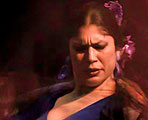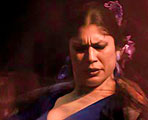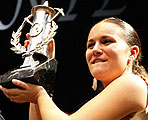Interview: Estela Zatania
«Do what feels most rewarding, and you're bound to end up in the right place»
|
When fellow dancers and musicians couldn’t pronounce her name, “Lakshmi”, they gave her a very flamenco nickname: “Chimi”. She’s American, from California, but with such a diversity of cultural roots, it’s impossible to pinpoint her ethnicity. Energetic and full of life, as is only natural for her age, Chimi’s pseudo indigenous American features are easily mistaken for gypsy. Maybe that’s it. Maybe she looked in the mirror one day, saw her face was made for flamenco and her body for dance. From a family that is both artistic and international, Chimi arrived in Spain a decade ago, and followed a path that has led to her to dance in the Bienal de Flamenco de Sevilla, and make the final rounds of the prestigious contests of Córdoba and La Unión. In the United States, she has produced and starred in two works of her own, and is now immersed in the challenge of her first production within Spain which is scheduled to debut on November 25th in Lebrija.
American, but with some Hispanic roots, is that right? Yes, I have a lot of mixture. Since people always ask, I even wonder myself, why I look the way I do and seem so flamenco, I made it my business to find out something about my family’s background. My mother is from Argentina and my father from California, with Irish, Dutch and German roots, in other words, real American. My grandparents on my mother’s side emigrated to Argentina, my grandmother to Paraguay, half indigenous half Spanish. There is also something of Sephardic Jew, and my other grandfather is half Egyptian half Sicilian, that’s where I get the blue eyes and dark hair. My parents are performing artists, and both are from artistic families. My father is a musician and my mother is an all-round artists, she has an aunt in Paraguay who has a dance school that teaches both Paraguayan folk-dance and flamenco…just think, a flamenco dance school in Paraguay! I couldn’t believe it, because this is a school that already existed in the 1940s! My mother was a classic dancer and flamenco dancer, also an actress and musician. In the 1960s she lived in Barcelona where she sang and danced in a tablao, and also worked in my father’s group. My parents have a band that plays gypsy and Californian music: “Electrocarpathians”. My dad plays with all kinds of groups, from classical music to traditional Jewish, and he also composes. A little of everything! Much more in Spain. Once a year I go to the States, for a month or two at the most. Where do you feel more at home? I feel much more at home in Seville, as far as day-to-day life. But really I feel at home anywhere in the world as long as I’m under the same roof with my people. That’s why it’s so difficult to be far away from them. My home is divided by land and sea. “I don’t like shows put on by big companies, with seven dancers all doing siguiriyas, it doesn’t even feel like siguiriyas. It also bugs me when people think if they take a few classes and learn a choreography, they know what flamenco is”.
What dancers or historic maestros inspire you most? Of current people, Angelita Vargas and Manuela Carrasco. The classic artists inspire me, whether it’s Titi de Triana or an unknown person from Jerez or Cádiz. Carmen Amaya. I like oldtimers and current dancers, but of the current ones, I do prefer the older artists. Very often I get inspired by the most unexpected person, whether or not they’re professional, but flamenco and with something to say. Before you got into flamenco dance, did you do other styles like jazz, classic ballet, modern dance…? Yes, many different styles. Jazz, classic ballet, contemporary, tap, folk-dancing from Ireland, Mexico and Paraguay, hip-hop, break-dance and a lot of oriental dance. What I like most is classic ballet and break-dance. But what sent me to another plane of existence was flamenco. It’s like I connect with the spirits of my ancestors, because it’s not even normal what I feel when I really get into the dance. Now is when I’m studying, getting a solid background and really delving into it, but long before I had any formal training, I already had my own concept of flamenco dance. How did that love-affair with flamenco begin? I was just a little girl…my first recollection of flamenco was when I was about 3, and I remember I was standing up, holding on to my mother’s hand, and all I could see were polkadot ruffles and three female singers. The three were, and continue to be friends of the family, from years and years ago. They’re Spanish, and for personal and professional reasons they moved to the U.S. These were the people who began a flamenco community. When I was small, it was just a group of friends who got together to be able to speak Spanish and enjoy a little flamenco. Almost none of them were professional. My mother also left flamenco long before meeting these people. But they would get together to sing, dance, have some drinks and a few laughs. The fiesta grew bigger and bigger as outsiders would come just to listen and watch. That’s where my initial knowledge of flamenco came from, in an informal fiesta setting. I identified with flamenco more than with other kinds of dance I’d known and which surrounded me. Would you say your flamenco dancing could be classified as “traditional”? I don’t know, I guess so. What is your opinion of the avant-garde line other young dancers are following? Are you attracted to that?
Many non-Spaniards think flamenco is just dance…do you think they learn to appreciate cante? What importance does cante have for you? When a non-Spaniard comes to realize the importance of cante, that’s when they begin to really understand flamenco and also dance. For me, cante is the root of flamenco, the beginning, the seed. It’s the most important thing. And I love to sing, but I don’t do it very well, although I study it in my own way all the same. Has the UNESCO naming of flamenco as a world cultural heritage affected you personally?…or has it not made any difference? What does it mean for flamenco in general? This is something we have to wait a few years to really know the outcome. It’s interesting because yes, it’s true flamenco is popular the world over. It’s known and studied in many countries. Just look at me, I was exposed to flamenco as a child far away from Spain…and I actually lived it. I didn’t even study (well, I did, in a limited way before coming to Spain). But I’m not so sure I like the way flamenco is becoming a global artform. For example, I don’t like shows put on by big companies, with seven dancers all doing siguiriyas, it doesn’t even feel like siguiriyas. It also bugs me when people think if you take a few classes and learn a choreography, they know what flamenco is. In my opinion, flamenco is much more complex, it’s all day, every day, not just the studio time. It’s a way of life. On the other hand, I think this all generates work. Flamenco is going to be like classic ballet, an artform with a global audience. Eventually, that means more work both within and outside of Spain. And that’s a good thing, because I’ve been making my living from flamenco for over thirteen years. It’s been my bread and butter even from before coming to Spain at 20. “It’s true that today some dancers no longer improvise, but for me it’s one of the most important elements of flamenco, the spontaneity. In all my dances I always leave room for improvisation”. A few months ago you were finalist at the prestigious Córdoba contest, and all the contest of Las Minas de La Unión…at both events it’s an admirable achievement to reach the finals. In La Unión you got second prize, while in Córdoba the prize was declared void. At these contests, or any other moment in your career, have you ever felt discriminated against for being a foreigner? Many times I’ve felt discrimination, it’s only normal. People don’t understand how a foreigner can be working in flamenco. And it annoys them even more when I start dancing and maybe I can be just as flamenco or more so than them. I may not know as much, but my character is more flamenco. And of course, I don’t mean this happens all the time, but when it does, it triggers bad reactions. This is easing up little by little, people are getting to know me. And I wouldn’t hesitate to participate in a contest again. In my opinion, contests are an excellent form of preparation and they help people know who you are. I signed up for both contests for these reasons. Bringing home a prize was something completely unexpected, so it was a real success as far as I’m concerned. In Córdoba there were some unkind comments about your not being Spanish. How do you deal with that? I don’t care what people say, because when I’m dancing I know exactly who I am. I don’t need anyone’s okay, because in any case, I’m going to dance just as well or as badly. What does bother me is when I’m working and the people behind me don’t give their support. It doesn’t happen a lot, but on occasion it does, and I can’t stand that, because I like to give my all but it’s impossible when you have to work with people who aren’t on your side. Fortunately it happens less and less all the time. Do you choreograph your own material? Nowadays it’s fashionable to claim there’s no improvisation in flamenco, that everything is rehearsed and there’s no variation. To what extent do you improvise or feel inspired by the moment? I do my own choreographies. The first time I danced flamenco professionally I was 15, I set a farruca for myself and did it according to what the guitarist played. It’s true that today some dancers no longer improvise, but for me it’s one of the most important elements of flamenco, the spontaneity. In all my dances I always leave room for improvisation, and often that’s where I feel most inspired, it can be better than the choreographed parts. I love to feel inspired by the moment, for me that’s real flamenco, and it’s the most difficult thing! You’re now preparing a show with your own company. Is it a private initiative, or do you have sponsorship or grants? It’s private, but I hope to receive economic support in order to be able to develop the show better. On my own, the way I’ve been all my life, I’m very limited because I don’t have money. I began working when I was 11 because my family was pretty much lower-middle class, and everything I’ve earned has been reinvested in my dancing. The show is a terrific idea from my friend Miguel Ángel Vargas, and the numbers are of my own creation of course. How do you deal with the responsibility of heading your own group and being the central figure? I manage quite well because it’s nothing new for me. I been presenting my own shows in the United States for six years. It’s even more responsibility over there, because I do everything myself. The production, the media, etc., in addition to being the main dancer. Does this new show have a story line, or is it straight-ahead dancing? Striclty speaking, there’s no story line, but there is a general framework we use as the basis for the various dances. The only thing out of the usual is the character of the poet, Diego Vargas. He’s the one who “tells” the story of Zarabanda, while the rest of the artists interpret dance, guitar and cante.
Is it an original idea of yours? The idea is from Miguel Ángel Vargas, who is the stage director. I take care of the dance part, but he guides us so everything makes sense and has coherence. It’s a project we’ve developed with gypsies from Lebrija, Morón, Jerez and Sevilla. The idea is to create an enjoyable show, but one which has depth…traditional at the same time as original. What musicians and dancers make up the group? The singers are David El Galli from Morón, Jesús Flores and Enrique de Morón. On guitar we’ve got Antonio Moya and Juanma Torres, and I do the dancing. Some of these people were also with me in Córdoba and La Unión, I identified with their way of feeling flamenco. Miguel Ángel also has his regular collaborators, professionals from the world of theater and flamenco, and we also have the graphic work of the great Miguel Ángel de Alcalá, and audiovisual material of Teppei Nogaki. The work has an intriguing title, what was it? The work is called «La Zarabanda, lo que duerme en el cuerpo de los gitanos» [Zarabanda, she who inhabits the body of the gypsies”]. It’s from an actual poster used to announce a fiesta on the outskirts of Lebrija from when flamenco wasn’t even called flamenco, but already had most of the elements. I play the role of Zarabanda. Who or what is Zarabanda? Well, that’s what the audience has to find out for themselves. Is the work a defense of gypsy culture? It’s true the work deals with gypsies, but also with the oldest sort of flamenco, because they are stories which are inextricably linked. Miguel Ángel Vargas is an investigator and also a gypsy, he knows a lot about the history and brought this poster to my attention. I find it very interesting because it’s the beginning of flamenco…it’s genesis so to speak. This is one of the first posters to refer to gypsy music and dance in Andalusia. It’s even more interesting that in that era there were many political movements in Andalusia. The last gypsy prisoners from the historic Gran Redada were released in 1781, and in 1787 they were accepted as Spanish citizens with full legal rights under Carlos III, shortly after the American war of Independence. This poster is the basis for the show, it’s set in 1781 and the complete text says: “The Devil sleeps in the bodies of the gypsies and awakens with Zarabanda. Be advised. At the Venta del Caparrós a half league from Lebrija, the ninth day of July of the year 1781 = Dances of Aurora, Andrea la del Pescado = Mojiganga del Caracol = Zarabanda = Four couples of men and women”. We hope to recreate that moment with its historic and artistic backdrop. I identify with gypsies in flamenco, and in my way of understanding flamenco. There are various gypsy groups that exist throughout the world, and not all are the same. In actual fact, I identify with people, wherever they’re from, who have values and sensitivity similar to mine. Diego Carrasco summed it up perfectly, and I agree with him a hundred percent: I’m a tenant of the world! And lastly, what would you say to a young non-Spaniard who wanted to become a dancer?…what advice would you give? If you want to dance, dance. Don’t be so hesitant, do what feels most rewarding, and you’re bound to end up in the right place.
|
||||||||
Descubre más desde Revista DeFlamenco.com
Suscríbete y recibe las últimas entradas en tu correo electrónico.





























